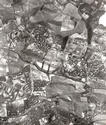 Until the 1950s Greater Easterhouse contained around thirteen working farms. Housing developments were proposed in the 1930s, but postponed because of the Second World War. In addition to farming there was mining and quarrying. Farming declined as housing development expanded although there remains a working farm at Blackfaulds, near Craigend.
Until the 1950s Greater Easterhouse contained around thirteen working farms. Housing developments were proposed in the 1930s, but postponed because of the Second World War. In addition to farming there was mining and quarrying. Farming declined as housing development expanded although there remains a working farm at Blackfaulds, near Craigend.
 From 1960 schools and shops opened. The population reached 56,843 in 1971 and a shopping centre opened in 1972. The collapse of Glasgow's traditional industries produced low income levels and the area's remoteness from the city created a sense of isolation. "Homesteading", where council houses in need of renovation were offered for sale if the purchasers took responsibility for undertaking their repair, was tried without success and the population had fallen to 45,708 by 1981. The Voice was published to mobilise community solidarity and the churches played a role in creating a network of pastoral and social services.
From 1960 schools and shops opened. The population reached 56,843 in 1971 and a shopping centre opened in 1972. The collapse of Glasgow's traditional industries produced low income levels and the area's remoteness from the city created a sense of isolation. "Homesteading", where council houses in need of renovation were offered for sale if the purchasers took responsibility for undertaking their repair, was tried without success and the population had fallen to 45,708 by 1981. The Voice was published to mobilise community solidarity and the churches played a role in creating a network of pastoral and social services.
 In the 1980s community organisations acted to stop the media focus on gang fighting while local arts projects succeeded in reviving community consciousness and identity. This process continued with the Greater Easterhouse Partnership, an area management unit designed to maximise investment for social and economic development. There are now over 200 community organisations operating in the fields of health, environment, sports and the arts. In 2000 a purpose-built campus for John Wheatley College, formerly housed in an old school building, was completed.
In the 1980s community organisations acted to stop the media focus on gang fighting while local arts projects succeeded in reviving community consciousness and identity. This process continued with the Greater Easterhouse Partnership, an area management unit designed to maximise investment for social and economic development. There are now over 200 community organisations operating in the fields of health, environment, sports and the arts. In 2000 a purpose-built campus for John Wheatley College, formerly housed in an old school building, was completed.
The population has continued to fall and is now around 32,000. However recent developments may succeed in halting this decline. The area now has a balanced mix of owner-occupied and rented housing in fourteen neighbourhoods with names that recall the farmsteads of the 1950s.